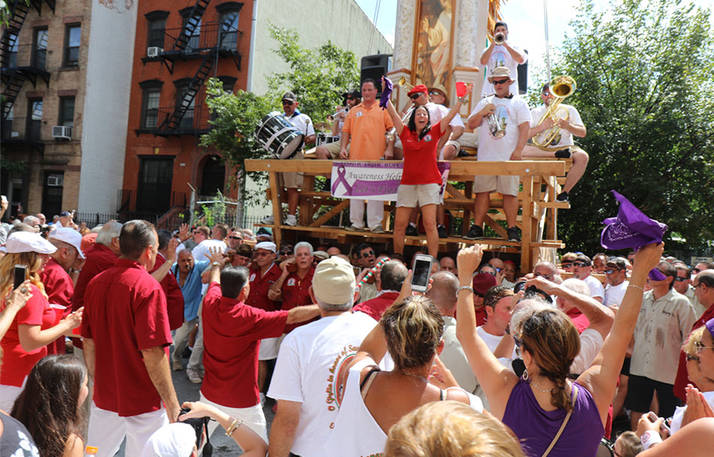


Harlem is one of the most well-known neighborhoods in New York City; however, not many people think of Italians when they hear the neighborhood’s name. Harlem was once the largest Italian neighborhood in the entire nation. Despite today's diminished Italian population in Harlem, one of the city’s largest Italian festivals is actually still held annually there, and this festival is unlike anything you’ve ever seen before. Thanks to the East Harlem Giglio Society, it’s possible to watch men and women carry a massive tower, called a Giglio, on their backs in honor of Saint Anthony of Padua [2]. The tower ranges anywhere between 75 to 85 feet in height and up to 5 tons! This year's event will be held on August 13 from 1pm-7pm at Our Lady of Mt. Carmel Shrine Church (456 East 116th Street, New York, NY 10029).
Italian Roots
As waves of immigrants left Italy at the turn of the 20th century, Harlem was one of the first places that Italians settled. A good number of these immigrants came from the town of Brusciano [3]. They brought their traditions with them, and one of these traditions just happened to be the Dance of the Giglio, which honors Saint Anthony of Padua. The first festival occurred around 1908, and fairs continued being held until 1971. In 2000, the Dance of the Giglio returned as a Cooperative Feast with the Shrine Church of Our Lady of Mt. Carmel [4], which is on 115th Street between 1st Ave. and Pleasant Ave. In 2006, the feast was separated from the Dance of the Giglio, and the Dance is now held on the second Sunday of August.
The Giglio
The centerpiece of this dance is, of course, the Giglio tower. The word giglio in Italian translates to “lilly” in English. The towers were given this name because they are traditionally decorated with lilies. The structure is made from wood and the facade from papier-mâché. Giglios have their origins in Nola [5], Italy in the year 409 AD. Now, Giglios are danced in many cities around Naples, and, clearly, even here in New York. Each city or town has its own spin on the tradition. In Brusciano, the city whose Giglios inspired New York’s, six Giglios are made and danced in August in order to honor Saint Anthony. Above the Giglio’s base sits a multi-piece band along with singers. It takes 120 people to lift the whole structure and dance it through the streets.
The Giglio Society of East Harlem
In order to organize such a large event, a team of people is necessary. The Giglio Society of East Harlem grew as a result of that early 20th century Italian immigration, and today it is made of individuals who continue to honor Saint Anthony. The Society describes itself as “a diverse religious and cultural organization of Catholics of Our Lady of Mt. Carmel Shrine Church in East Harlem New York City. Under the auspices of the Catholic Church and the United States Catholic Conference, we are dedicated to honoring and encouraging devotion to our patron Saint Anthony of Padua by organizing and producing our annual Giglio and procession. In addition: our mission includes, in what was once the largest Italian neighborhood in the United States, preserving the Italian American traditions, culture, history and heritage; and strengthening the older and current community. East Harlem is one of the most undeserved and poorest communities in New York City, by supporting, both morally and fiscally via the Catholic Church and our neighborhoods other non-profit institutions which seek to improve the lives of our neighbors and community members.”
As with other Italian festivals, there will of course be street vendors and plenty of food. To find more information about the East Harlem Giglio Society and their events/outings, visit their official website. >>> [6]
Source URL: http://test.iitaly.org/magazine/focus/facts-stories/article/harlems-giglio-feast-raising-five-ton-tower
Links
[1] http://test.iitaly.org/files/gigliosocietyeatharlemnewyorkjpg
[2] http://www.catholic.org/saints/saint.php?saint_id=24
[3] http://www.comune.brusciano.na.it/
[4] https://www.olmcchurchbk.com/
[5] https://www.comune.nola.na.it/
[6] https://www.eastharlemgiglio.org/